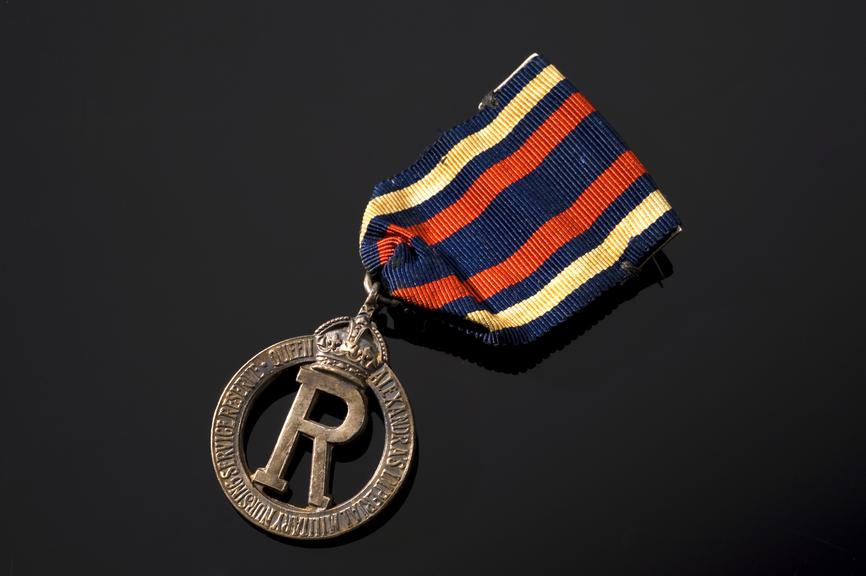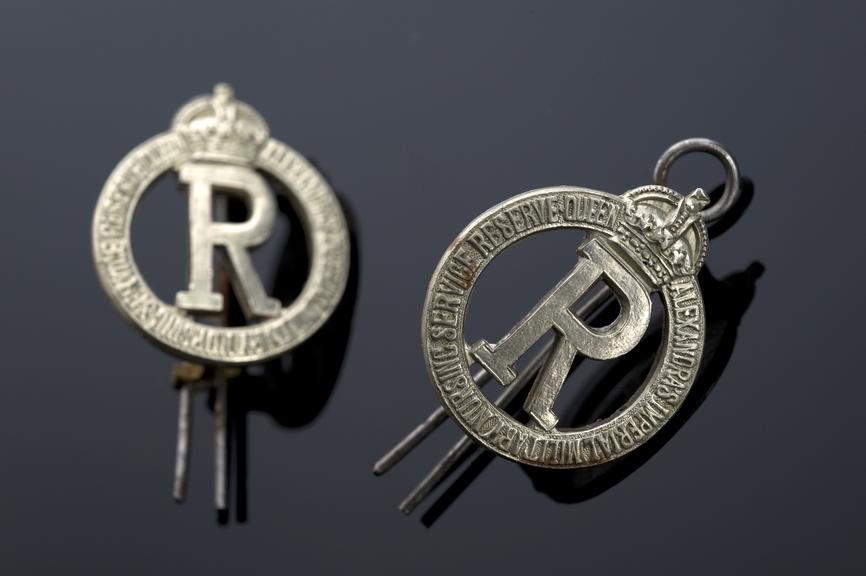Grey wool shoulder cape edged with red felt
Grey wool shoulder cape edged with red felt, worn by Elizabeth Batten, Senior sister in Queen Alexandra's Imperial Military Nursing Service Reserve, at the Royal Free Hospital, London, 1910-1920




Collection of medals, badges and other uniform items belonging to Elizabeth Batten, senior sister in Queen Alexandra's Imperial Military Nursing Service Reserve at the Royal Free Hospital, 1910-1920
Grey wool shoulder cape edged with red felt, worn by Elizabeth Batten, Senior sister in Queen Alexandra's Imperial Military Nursing Service Reserve, at the Royal Free Hospital, London, 1910-1920
Silver belt buckel in two parts, with interlocked floral and foliage pattern, worn by Elizabeth Batten, Senior Sister in Queen Alexandra's Imperial Military Nursing Service Reserve at the Royal Free Hospital, 1900-1920
Cased R.R.C. medal, Garrard and Co. Ltd., 24 Albemarle Street, London, England, 1914-1918; awarded to Elizabeth Batten, Senior Sister in Queen Alexandra's Imperial Military Nursing Service Reserve at the Royal Free Hospital
The Royal Red Cross (RRC) medal was only awarded to women from the time it was created in 1883 until 1976, when men also became eligible. The medal was given to members of the nursing service. This particular medal was given to Elizabeth Batten, a Senior Sister in Queen Alexandra’s Imperial Military Nursing Service (QAIMNS) Reserve, for her nursing services during the First World War. The words “Faith” “Hope” and “Charity” are inscribed on the back.
This is an example of a second-class award that was introduced in 1915. A nurse could become a first-class member (RRC) when she had received two second-class awards.
Silver badge of the Royal Free Nurses League, 1910-1920; worn by Elizabeth Batten, Senior Sister in Queen Alexandra's Imperial Military Nursing Service Reserve at the Royal Free
This badge was owned by Elizabeth Batten, a nurse who served during the First World War. As a member of the Royal Free Nurses’ League she was entitled to wear it.
The League was an association for all trained nurses in the United Kingdom. Princess Christian of Schleswig-Holstein was patron of the league and the crown in the centre of the badge is a symbol of her patronage. In the early 1900s, nursing was a female-only profession.
Insignia of Queen Alexandra's Imperial Military Nursing Service Reserve, awarded to Elizabeth Batten, Senior Sister at the Royal Free Hospital, silver, 1916
This insignia was awarded to Elizabeth Batten, a Senior Sister in Queen Alexandra’s Imperial Military Nursing Service (QAIMNS) Reserve, for her duties during the First World War.
The QAIMNS was created in 1902 and expanded in the run-up to the First World War in anticipation of the increased need for medical staff and supplies. All nurses in the QAIMNS wore this insignia on the right breast of their uniform and is also known as a cape badge.
Two metal badges of Queen Alexandra's Imperial Military Nursing Service Reserve, worn by Elizabeth Batten, senior sister at the Royal Free Hospital, 1910-1920
Elizabeth Batten, a Senior Sister in Queen Alexandra’s Imperial Military Nursing Service (QAIMNS) Reserve wore these badges to show her membership in the Reserve. The QAIMNS was created in 1902 and expanded in the run-up to the First World War in anticipation of the increased need for medical services. Nursing was mostly a female profession until after the Second World War.

Calling card of Elizabeth Batten, A.R.R.C., who had been senior sister in the Q.A.I.M.N.S. Reserve at the Royal Free, 1918-1925



